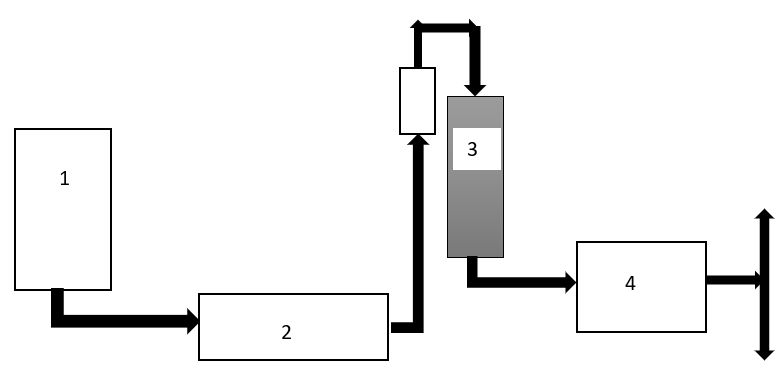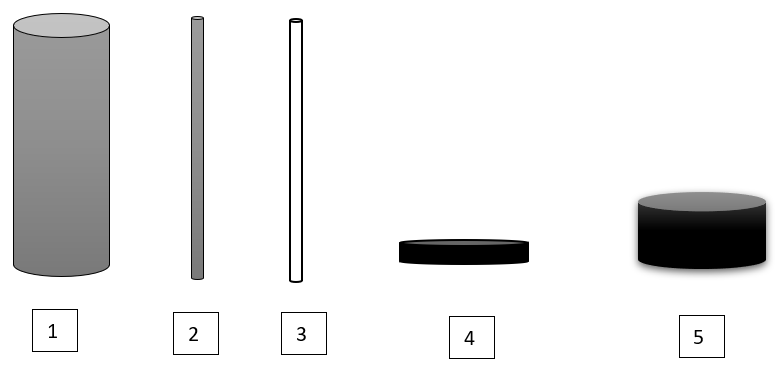This set of Bioseparation Science Multiple Choice Questions & Answers (MCQs) focuses on “Chromatography System”.
1. Label the given diagram for the chromatographic system.

a) 1-Mobile phase reservoir, 2-pump, 3-column, 4-detector
b) 1-pump, 2-Mobile phase reservoir, 3-column, 4-detector
c) 1-pump, 2-Mobile phase reservoir, 3-detector, 4-column
d) 1-detector, 2-pump, 3-column, 4-Mobile phase reservoir
View Answer
Explanation: System involved in chromatographic separation consists of a column, mobile phase reservoir, pump, sample injector, detector and a fraction collector. The initial part is the reservoir of the mobile phase connected to the reservoir there is a pump to carry the mobile phase to the column along with the sample then through column the sample and the mobile phase moves to the detector and after getting detected, the product as well as wastes are separated.
2. The system of chromatography is of various types based on ___________
a) mobile phase
b) pump
c) detector
d) column
View Answer
Explanation: The chromatographic separation system is divided into various types based on the type of column used for the separation process. The various types of column used in the chromatographic separation are packed bed, packed capillary, open tubular, membrane and monolith.
3. Which is the most widely used type of column for the chromatographic separation in bioseparation engineering?
a) Packed capillary
b) Packed bed
c) Membrane
d) Open tubular
View Answer
Explanation: The packed bed column is widely used for the chromatographic separation process since it is allows most of the samples to pass easily and get separated than any other column. It is also not very specific for any process.
4. The packed capillary as well as open tubular are specifically used for ____________
a) chromatography
b) pulse chromatography
c) analytical chromatography
d) preparative chromatography
View Answer
Explanation: The analytical chromatography demands for the specific column which have capillary action more relevant than a membrane or wide bed column. The capillary and the tube like columns are mainly recommended for the analytical purpose of separation.
5. Membrane columns are mainly used in _____________
a) chromatography
b) pulse chromatography
c) analytical chromatography
d) preparative chromatography
View Answer
Explanation: The membrane columns are preferred in the pulse chromatography due to its small bed height and the membranes are fixed in the column for the specific sample to be separated through chromatography.
6. Which chromatography process is known as step chromatography?
a) Bind and elute chromatography
b) Pulse chromatography
c) Analytical chromatography
d) Preparative chromatography
View Answer
Explanation: The step chromatography works like the process of adsorption. The binding of the sample takes place in the membrane based column and the elution takes place after getting separated into product and waste.
7. Which column are preferred more in analytical chromatography now-a-days?
a) Packed capillary
b) Packed bed
c) Membrane
d) Monoliths
View Answer
Explanation: The monoliths have large bed heights than the membrane column which can hold more area for the separation of the sample from the wastes.
8. Name the following columns.

a) Packed bed, packed capillary, open tubular, membrane, monoliths
b) Packed capillary, packed bed, open tubular, membrane, monoliths
c) Packed bed, open tubular, packed bed, membrane, monoliths
d) Packed capillary, packed bed, open tubular, monoliths, membrane
View Answer
Explanation: The packed bed column is wide and it can allow passage of most of the samples as compared to the capillary column. The open tubular column is hollow in comparison to the capillary column used for the process of separation in chromatography. The membrane has less surface for the samples to pass through the column than the monoliths, therefore, monoliths can be used for the most of the analytical processes.
9. What are the different separation mechanisms used for the process of chromatographic separations?
a) Ion exchange, reverse phase
b) Hydrophobic interactions, affinity
c) Size exclusion
d) Ion exchange, reverse phase, hydrophobic interactions, size exclusion, affinity
View Answer
Explanation: The separation mechanisms are based on the interactions of the sample with the column depending on the type of column used in the separation methods of bioseparation and the separation mechanisms are ion exchange, hydrophobic interaction, affinity, size exclusion and reverse phase.
10. Which chromatography mechanism is based on the use of inert porous particles?
a) Size exclusion
b) Hydrophobic interaction
c) Affinity
d) Reverse phase
View Answer
Explanation: Size exclusion chromatography is also known as gel filtration chromatography. It is based on the use of inert porous particles as a stationary phase and separation of solutes are based on the basis of size.
Sanfoundry Global Education & Learning Series – Bioseparation Science.
To practice all areas of Bioseparation Science, here is complete set of 1000+ Multiple Choice Questions and Answers.
If you find a mistake in question / option / answer, kindly take a screenshot and email to [email protected]
